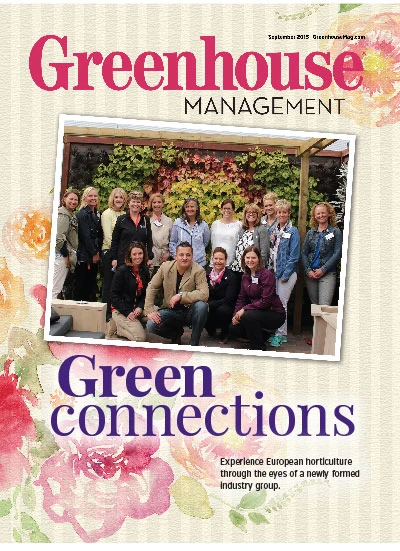| One of the key factors in optimum plant growth is providing adequate light for photosynthesis. During the summer, with long days and high sun angle, this is not a problem; however, during the fall, winter and spring, light levels are usually marginal. Add to this the loss of light due to greenhouse glazing and the obstructions in the greenhouse and the light that gets to plants is usually less than is needed for optimum plant growth. The Daily Light Integral (DLI) was developed by scientists to provide a measure of cumulative photosynthetically active radiation (PAR) received by plants over the course of the day. It integrates light intensity in micro-mols per square meter per second (μmol/sq m-sec) and totals this over a 24-hour period. The total daily integral is expressed as mols per square meter per day (mols/sq m–day). The concept is similar to totaling daily rainfall measured in inches per day. Total daily light requirements vary considerably between different plant species.
A good resource that provides DLI information on many crops is the Purdue Extension publication on daily light intervals — www.extension.purdue.edu/extmedia/ho/ho-238-w.pdf. Seasonal monthly DLI has been published in maps prepared by Dr. James Faust at Clemson University, which are included in the above link. These are good for getting average light, but need to be adjusted down to compensated for the loss through the glazing and greenhouse structure. Many environmental control computers include DLI in the weather data that they obtain. Light sensors both outside and inside the greenhouse at plant level will give accurate totals and can be used to adjust crop production schedules or crop timing. The Spectrum Technologies, Inc. (www.spectmeters.com) Watchdog Model 2475 Plant Growth Station has the capability to record four environmental factors, including light. It requires a software package for your PC to integrate instantaneous readings into a DLI.
If the measured DLI is less than what is recommended, supplemental light could be supplied to make up the difference. This can be either high-intensity discharge (HID) sodium vapor or metal halide or one of the light-emitting diode (LED) lights developed for plant growth. An economic analysis should be done before purchasing supplemental lighting as it is marginal for most crops due to the high cost of electricity. Light levels inside the greenhouse are reduced from 25 to 50 percent due to losses through the glazing and the shading from the structure. I have measures readings as low as 35 percent in a house that had old fiberglass glazing. Cleaning or replacing the glazing, moving some of the overhead obstructions (heat and water pipes, electrical conduit, poly ducting) can have a significant effect. Also, when building new greenhouses, locate the utilities along sidewalls or under the floor to reduce potential shade.
Bartok is a regular contributor to Greenhouse Management and an agricultural engineer and emeritus extension professor at the University of Connecticut. He is an author, consultant and a certified technical service provider doing greenhouse energy audits for USDA grant programs in New England. Have a question? You can write John at jbartok@rcn.com.
|

Explore the September 2015 Issue
Check out more from this issue and find your next story to read.
Latest from Greenhouse Management
- Anthura acquires Bromelia assets from Corn. Bak in Netherlands
- Top 10 stories for National Poinsettia Day
- Langendoen Mechanical hosts open house to showcase new greenhouse build
- Conor Foy joins EHR's national sales team
- Pantone announces its 2026 Color of the Year
- Syngenta granted federal registration for Trefinti nematicide/fungicide in ornamental market
- A legacy of influence
- HILA 2025 video highlights: John Gaydos of Proven Winners







